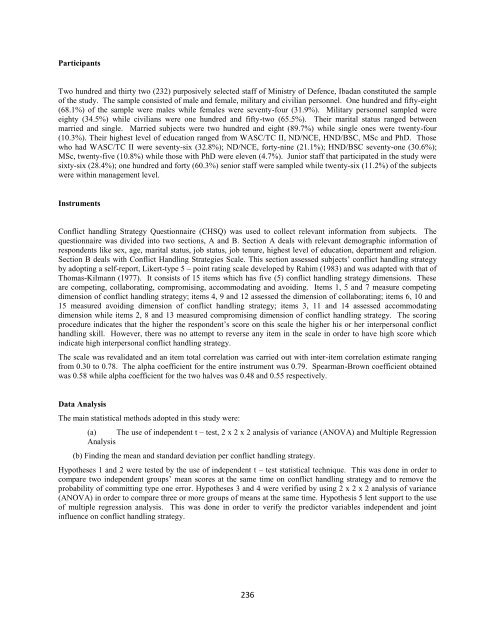Download complate issue - Ozean Publications
Download complate issue - Ozean Publications
Download complate issue - Ozean Publications
You also want an ePaper? Increase the reach of your titles
YUMPU automatically turns print PDFs into web optimized ePapers that Google loves.
ParticipantsTwo hundred and thirty two (232) purposively selected staff of Ministry of Defence, Ibadan constituted the sampleof the study. The sample consisted of male and female, military and civilian personnel. One hundred and fifty-eight(68.1%) of the sample were males while females were seventy-four (31.9%). Military personnel sampled wereeighty (34.5%) while civilians were one hundred and fifty-two (65.5%). Their marital status ranged betweenmarried and single. Married subjects were two hundred and eight (89.7%) while single ones were twenty-four(10.3%). Their highest level of education ranged from WASC/TC II, ND/NCE, HND/BSC, MSc and PhD. Thosewho had WASC/TC II were seventy-six (32.8%); ND/NCE, forty-nine (21.1%); HND/BSC seventy-one (30.6%);MSc, twenty-five (10.8%) while those with PhD were eleven (4.7%). Junior staff that participated in the study weresixty-six (28.4%); one hundred and forty (60.3%) senior staff were sampled while twenty-six (11.2%) of the subjectswere within management level.InstrumentsConflict handling Strategy Questionnaire (CHSQ) was used to collect relevant information from subjects. Thequestionnaire was divided into two sections, A and B. Section A deals with relevant demographic information ofrespondents like sex, age, marital status, job status, job tenure, highest level of education, department and religion.Section B deals with Conflict Handling Strategies Scale. This section assessed subjects‟ conflict handling strategyby adopting a self-report, Likert-type 5 – point rating scale developed by Rahim (1983) and was adapted with that ofThomas-Kilmann (1977). It consists of 15 items which has five (5) conflict handling strategy dimensions. Theseare competing, collaborating, compromising, accommodating and avoiding. Items 1, 5 and 7 measure competingdimension of conflict handling strategy; items 4, 9 and 12 assessed the dimension of collaborating; items 6, 10 and15 measured avoiding dimension of conflict handling strategy; items 3, 11 and 14 assessed accommodatingdimension while items 2, 8 and 13 measured compromising dimension of conflict handling strategy. The scoringprocedure indicates that the higher the respondent‟s score on this scale the higher his or her interpersonal conflicthandling skill. However, there was no attempt to reverse any item in the scale in order to have high score whichindicate high interpersonal conflict handling strategy.The scale was revalidated and an item total correlation was carried out with inter-item correlation estimate rangingfrom 0.30 to 0.78. The alpha coefficient for the entire instrument was 0.79. Spearman-Brown coefficient obtainedwas 0.58 while alpha coefficient for the two halves was 0.48 and 0.55 respectively.Data AnalysisThe main statistical methods adopted in this study were:(a) The use of independent t – test, 2 x 2 x 2 analysis of variance (ANOVA) and Multiple RegressionAnalysis(b) Finding the mean and standard deviation per conflict handling strategy.Hypotheses 1 and 2 were tested by the use of independent t – test statistical technique. This was done in order tocompare two independent groups‟ mean scores at the same time on conflict handling strategy and to remove theprobability of committing type one error. Hypotheses 3 and 4 were verified by using 2 x 2 x 2 analysis of variance(ANOVA) in order to compare three or more groups of means at the same time. Hypothesis 5 lent support to the useof multiple regression analysis. This was done in order to verify the predictor variables independent and jointinfluence on conflict handling strategy.236
















